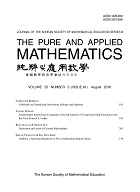 ISSN : 1226-0657
ISSN : 1226-0657
Browse Articles
- 2024 (Vol.31)
- 2023 (Vol.30)
- 2022 (Vol.29)
- 2021 (Vol.28)
- 2020 (Vol.27)
- 2019 (Vol.26)
- 2018 (Vol.25)
- 2017 (Vol.24)
- 2016 (Vol.23)
- 2015 (Vol.22)
- 2014 (Vol.21)
- 2013 (Vol.20)
- 2012 (Vol.19)
- 2011 (Vol.18)
- 2010 (Vol.17)
- 2009 (Vol.16)
- 2008 (Vol.15)
- 2007 (Vol.14)
- 2006 (Vol.13)
- 2005 (Vol.12)
- 2004 (Vol.11)
- 2003 (Vol.10)
- 2002 (Vol.9)
- 2001 (Vol.8)
- 2000 (Vol.7)
- 1999 (Vol.6)
- 1998 (Vol.5)
- 1997 (Vol.4)
- 1996 (Vol.3)
- 1995 (Vol.2)
- 1994 (Vol.1)
Vol.29 No.2
Abstract
In this paper we wish to establish some results relating to the growths of composition of two entire functions with their corresponding left and right factors on the basis of their generalized relative order (α, β) and generalized relative lower order (α, β) where α and β are continuous non-negative functions defined on (-∞, +∞).
Abstract
From the past until now, political and economic relations among countries have been one of the most important issues among analysts and numerous studies have tried to analyze these relations from different theoretical perspectives. The dynamic system of games has introduced a new modeling method in the game theory. In this study, we use behavioral models (level- k) along with the dynamic system in games to model rational agent behavior. As an application, we study Russia- Norway economic and political relations (1970-2019). The dynamic system in games along with behavioral games theory can be used to predict the players behavior in the future.
Abstract
For an arbitrary ample divisor A in smooth del Pezzo surface S of degree 2, we completely compute alpha invariant along curves when the ample divisor A is birational type.
Abstract
The aim of this note is to establish two known sums involving central binomial coefficients via a hypergeometric series approach. As an application, we discover two new closed-form evaluations of generalized hypergeometric function.
Abstract
In this paper we investigate the Hyers-Ulam stability of the s-variable additive and l-variable quadratic functional equations of the form <TEX>$$f\(\sum\limits_{i=1}^{s}x_i\)+\sum\limits_{j=1}^{s}f\(-sx_j+\sum\limits_{i=1,i{\neq}j}^{s}x_i\)=0$$</TEX> and <TEX>$$f\(\sum\limits_{i=1}^{l}x_i\)+\sum\limits_{j=1}^{l}f\(-lx_j+\sum\limits_{i=1,i{\neq}j}^{l}x_i\)=(l+1)$$</TEX><TEX>$\sum\limits_{i=1,i{\neq}j}^{l}f(x_i-x_j)+(l+1)\sum\limits_{i=1}^{l}f(x_i)$</TEX> (s, l ∈ N, s, l ≥ 3) in quasi-Banach spaces.
Abstract
In this paper, we introduce a new generalized (a, b)-cubic Euler-Lagrange-Jensen functional equation and obtain its general solution. Furthermore, we prove the Hyers-Ulam stability of the new generalized (a, b)-cubic Euler-Lagrange-Jensen functional equation in orthogonality normed spaces.
Abstract
Let X be a nodal complete intersection 3-fold defined by a hypersurface in ℙ<sup>5</sup> of degree n and a smooth quadratic hypersurface in ℙ<sup>5</sup> . Then we show that X is factorial if it has at most n<sup>2</sup> - n + 1 nodes and contains no 2-planes, where n = 3, 4.
